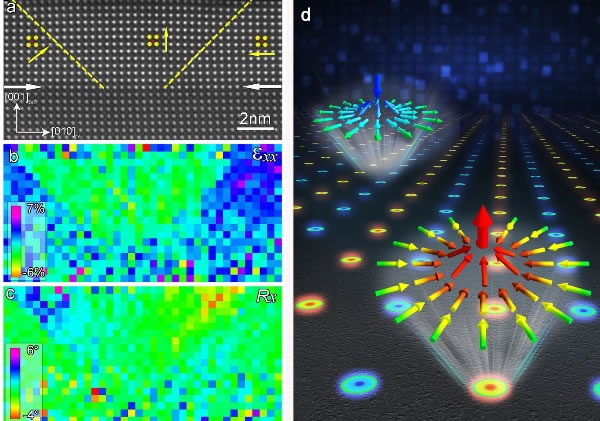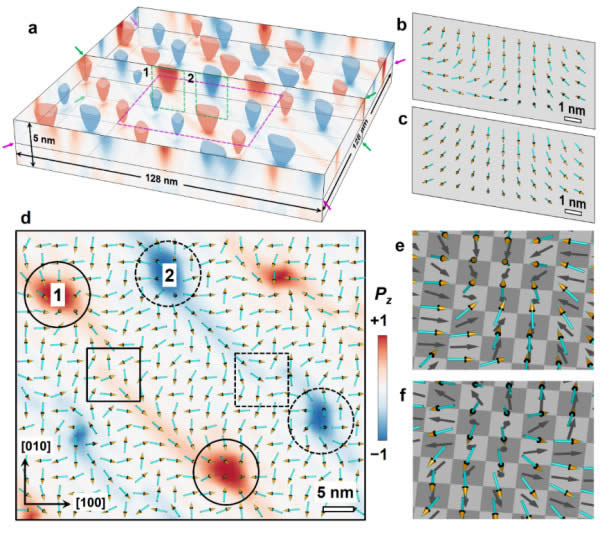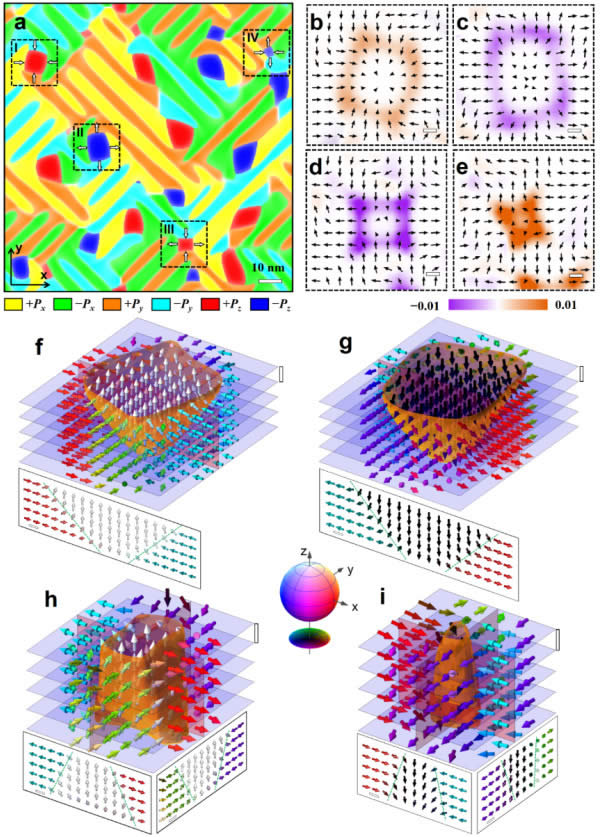The team of Ma Xiuliang from the Shenyang National Research Center for Materials Science, Institute of Metal Research, Chinese Academy of Sciences discovered the topological domains and periodic half-child lattices of Meron (also transliterated as Mai Ling) in oxide ferroelectric materials. This discovery is another major breakthrough in the topological domain structure of ferroelectric materials after the flux is fully closed (Science 2015), adding new substantive content to the structural characteristics analogous to ferromagnetic materials. It also provides new ideas for exploring high-density information storage devices based on ferroelectric materials. On June 1, Nature Materials published the research results online under the title of Polar meron lattice in strained oxide ferroelectrics. The work was designed and completed by Ma Xiulian, Zhu Yinlian, Wang Yujia, Feng Yanpeng, Tang Yunlong and others.
The topological domain structure has topological protection, which can save data for a long time, and has important application value in non-volatile information storage. However, the topological domains in ferroelectric materials generally contain continuous polarization rotations that are not allowed by body symmetry. How to break through the mutual restraint between ferroelectric polarization and lattice strain, realize the effective regulation of polarization reversal and lattice strain, and obtain the structural unit that is expected to be used for ultra-high density information storage is a basic faced in the field of ferroelectric materials today. Scientific puzzles.
After long-term academic accumulation, the research team has made breakthroughs in solving the above basic scientific problems in recent years. They have implemented strain regulation to construct a series of ultrathin ferroelectric PbTiO3/SrTiO3 multilayer films on scandate substrates. Using aberration-corrected electron microscopy with atomic scale resolution, not only found flux fully closed domains Structure and its novel atomic configuration map, and a large-scale periodic array composed of alternating arrangement of clockwise and counterclockwise closed structures was observed (Science 2015). On this basis, scientists at the University of California, Berkeley discovered the ferroelectric vortex domain array in the PbTiO3/SrTiO3 superlattice system with the same composition and different strain conditions using the same electron microscopy method (Nature 2016) ; Team member Tang Yunlong discovered the polarized lattice crystal lattice in PbTiO3/SrTiO3 superlattice during his visit to Berkeley National Laboratory in the United States from 2017 to 2019 (Nature 2019).
The halfton is a non-planar topological domain structure with a topological charge of ±1/2. The discovery of periodic half-child lattices in ferroelectric materials is based on the previous strain control method, the aberration-corrected electron microscopy imaging combined with phase field simulation makes the out-of-plane polarization unique to the half-child structure Presented in real space together with in-plane polarization. They found not only in-plane convergent and in-plane divergent halves in the ultra-thin PbTiO3 thin film (5nm) epitaxially grown on the SmScO3 substrate, but also found the inverse halon structure and the annihilation after the combination of the halons and inverse halons The domain structure with a topological charge of zero is formed. Through quantitative analysis of ion displacement in the aberration-corrected microscopic images, it was found that the half-sons and anti-half-sons form lattices according to a certain rule (convergent half-sons form a two-dimensional periodic square lattice of 8 nm×8 nm). Phase field simulations show that the formation of half-child lattice is beneficial to reduce the elastic energy of the system, so that the model containing half-child lattice has lower energy than the randomly distributed half-child model.
This work further improves the importance and effectiveness of adjusting the topological domain structure of ferroelectric materials through mismatched strains, and reveals that the electric dipole in the polarized system has a quasi-particle behavior similar to a special condensed structure under certain conditions. It is of great significance to explore high-density nonvolatile information storage devices based on ferroelectric materials. At the same time, the new ferroelectric topological domains can be presented in an intuitive form in real space, which shows that aberration-corrected electron microscopy with sub-angstrom resolution capability and quantitative analysis based on this are scientists' understanding of the structure of matter and the laws of nature Powerful means.

Figure 1: In-plane strain and lattice rotation information of convergent halves in PbTiO3 ultrathin films grown epitaxially on SmScO3 substrates (a, b, c); periodicity formed by alternate arrangement of convergent and divergent halves Schematic diagram of half-child lattice (d).

Figure 2: Atomic scale information of half-child lattice. (a) Three-dimensional display diagram; (b) Cross-sectional ion displacement diagram; (c) Planar ion displacement diagram; (d) Enlarged view of one half of the plane ion displacement diagram.

Figure 3: Phase field simulation results of the half-child lattice. (a) Three-dimensional display diagram; (b, c) cross-sectional polarization vector diagrams of convergent and divergent half-sons; (d) planar polarization vector diagrams of half-and anti-half-sons; (e, f) in figure d Three-dimensional polarized vector illustration of two half sons.

Figure 4: Phase field simulation results of the random half-submodel. (a) Horizontal cross-sectional view; (be) Polarization vectors and topological density distribution diagrams of four regions in Figure a; (fi) Three-dimensional polarization vector diagrams of these four topological domain structures.
Digital Curtain Fountain,Digital Fountain,Curtain Fountain,Water Curtain Fountain
Guangzhou Dewy water fountain Technology Co., LTD , https://www.dewywaterfountain.com